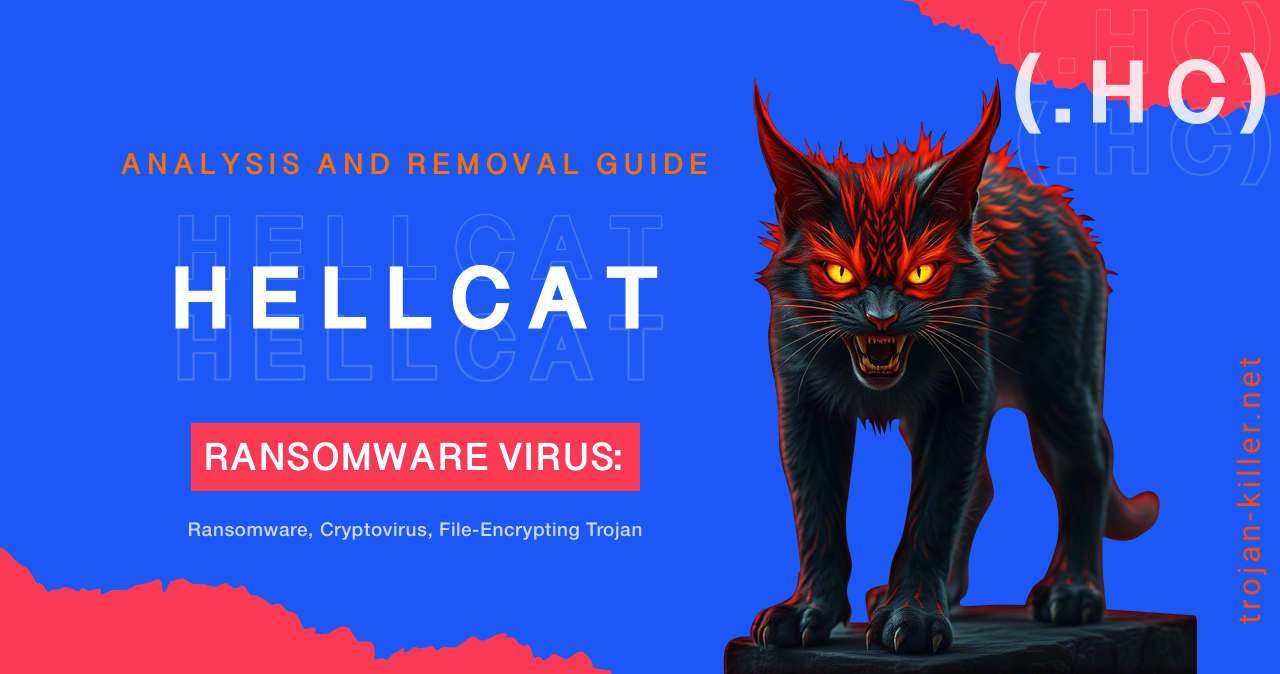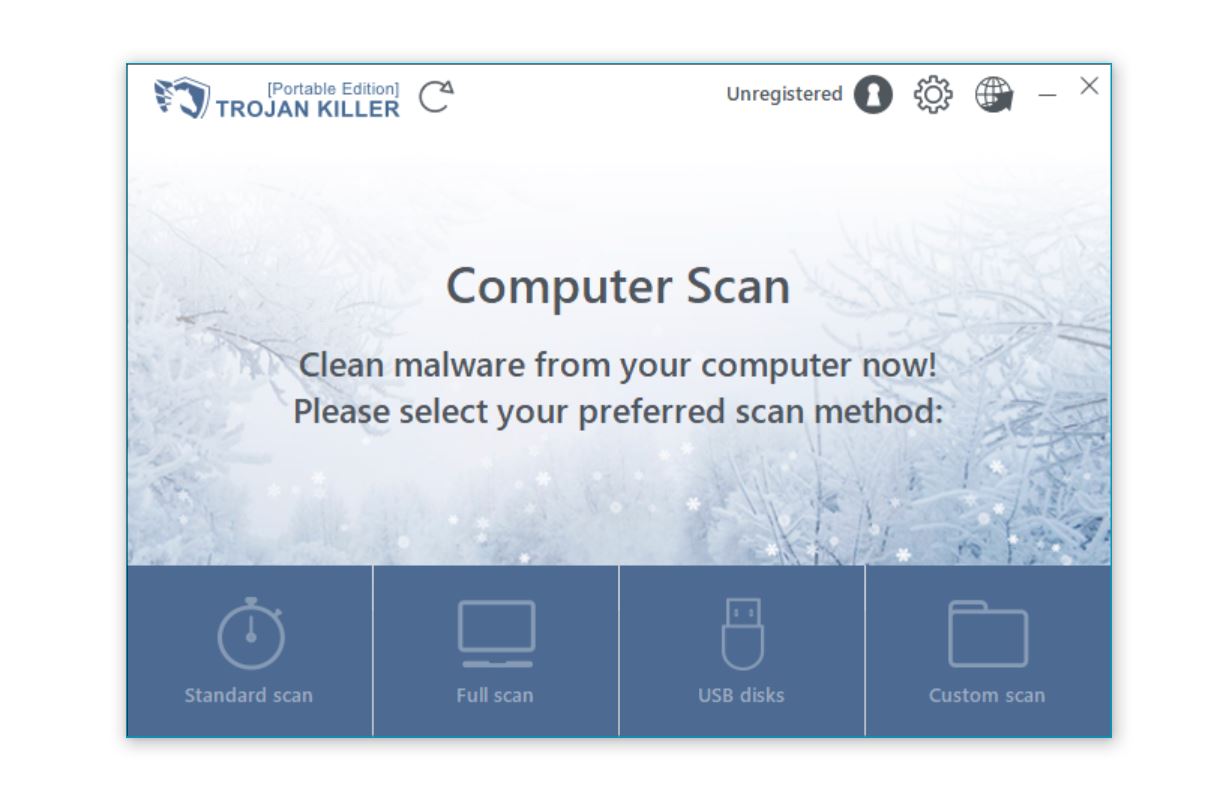Physical Address
Lesya Kurbasa 7B
03194 Kyiv, Kyivska obl, Ukraine
Physical Address
Lesya Kurbasa 7B
03194 Kyiv, Kyivska obl, Ukraine

Hellcat ransomware is a dangerous file-encrypting malware that targets Windows users, locking personal files and demanding payment for their recovery. This sophisticated threat combines strong encryption mechanisms with psychological manipulation tactics to extort victims. Unlike less destructive threats such as OfferCore, Hellcat directly compromises data accessibility and can lead to permanent file loss if not addressed properly.
| Threat Name | Hellcat Ransomware, Hellcat File-Encrypting Trojan, Hell.cat Ransomware |
| Type | Ransomware, Cryptovirus, File-Encrypting Trojan |
| Detection Names | Microsoft: Ransom:Win32/Hellcat.A, Trojan:Win32/Hellkzen.BC GridinSoft: Ransom.Win32.Hellcat, Trojan.Win32.Hellcat ESET: Win32/Filecoder.Hellcat.A Trend Micro: RANSOM_HELLCAT.A, TROJ_CRYPTLOCK.THFAH Kaspersky: Trojan-Ransom.Win32.Hellcat.a Symantec: Ransom.Hellcat |
| First Detected | 2023 (with significant evolution through 2025) |
| Platforms Affected | Windows 7, 8, 8.1, 10, 11 (Both 32-bit and 64-bit) |
| Distribution Methods | Phishing emails, malicious attachments, compromised downloads, exploit kits, RDP attacks |
| Encryption | AES-256 + RSA-2048 hybrid encryption |
| File Extension | .hellcat, .hc, .locked |
| Ransom Demand | $500-$2000 in Bitcoin (varies by variant) |
| Danger Level | High – Can cause permanent data loss and significant financial damage |
Hellcat is a sophisticated ransomware strain that emerged in 2023 and has since evolved into multiple variants with enhanced capabilities. It belongs to the file-encrypting ransomware family that uses strong encryption algorithms to lock victims’ files, making them inaccessible without the unique decryption key held by the attackers. Similar to other modern ransomware threats like LockBit 4.0 and Sarcoma, Hellcat employs a hybrid encryption system combining symmetric and asymmetric algorithms.
The threat actors behind Hellcat operate under a Ransomware-as-a-Service (RaaS) model, allowing affiliates to deploy the malware in exchange for a percentage of the ransom payments. This business model has contributed to its widespread distribution and continual technical refinement, making it an increasingly significant threat in the cybersecurity landscape.
Source: Analysis of Hellcat ransomware behavior patterns based on Microsoft Security Intelligence threat data, 2025
Hellcat ransomware demonstrates sophisticated technical capabilities that make it particularly effective and difficult to mitigate without specialized tools. Understanding its technical aspects is crucial for effective detection, prevention, and recovery.
Hellcat employs a two-tier encryption strategy that combines the speed of symmetric encryption with the security of asymmetric encryption:
This hybrid approach ensures that even if the encryption process is observed in memory, the critical AES key cannot be recovered without the attacker’s private RSA key, making decryption without payment technically infeasible in most cases.
Hellcat specifically targets valuable user data while avoiding system files to ensure the computer remains operational for ransom payment. The ransomware scans all accessible drives and network shares for files with these extensions:
# Document files.doc, .docx, .xls, .xlsx, .ppt, .pptx, .pdf, .rtf, .txt# Database files.sql, .accdb, .mdb, .dbf, .odb# Design files.psd, .ai, .cdr, .jpg, .jpeg, .png, .bmp, .tiff, .svg# Development files.php, .asp, .aspx, .js, .java, .py, .cpp, .cs, .h, .vb# Financial and accounting files.qbw, .qbb, .tax, .sdf# Archive files.zip, .rar, .7z, .tar, .gz, .bak |
Additionally, Hellcat avoids encrypting files in specific system directories and those associated with critical system functions to maintain system stability:
C:\Windows\C:\Program Files\C:\Program Files (x86)\\AppData\Local\Temp\\AppData\Roaming\Mozilla\\AppData\Roaming\Google\Chrome\\AppData\Local\Microsoft\Windows\ |
Before beginning the encryption process, Hellcat makes several critical system modifications to ensure its effectiveness:
| Modification | Technical Implementation | Purpose |
|---|---|---|
| Volume Shadow Copy Deletion | Executes vssadmin delete shadows /all /quiet and similar commands |
Prevent recovery from system backups |
| Backup Catalog Clearing | Runs wbadmin delete catalog -quiet |
Remove Windows backup capability |
| System Restore Disabling | Modifies registry settings for System Restore | Prevent system restore point usage |
| Security Software Termination | Identifies and kills processes associated with security solutions | Avoid detection and termination during encryption |
| Boot Configuration Alteration | Modifies boot settings to prevent recovery options | Complicate recovery attempts |
During infection, Hellcat creates several characteristic files on the victim’s system:
%TEMP%\hellcat.exe (Main executable)%APPDATA%\Microsoft\hellcat_worker.exe (Persistence mechanism)%DESKTOP%\HELLCAT-README.txt (Ransom note)%DESKTOP%\HELLCAT-DECRYPT.html (HTML version of ransom note)C:\ProgramData\hellcat_id.dat (Unique victim identifier)C:\hellcat_enc_log.txt (Encryption log - hidden) |
Hellcat makes the following changes to the Windows Registry to ensure persistence and execution:
# Persistence mechanismsHKCU\Software\Microsoft\Windows\CurrentVersion\Run "MSUpdater" = "%APPDATA%\Microsoft\hellcat_worker.exe"HKLM\SOFTWARE\Microsoft\Windows\CurrentVersion\Run "SystemCore" = "%TEMP%\hellcat.exe"# Disabling recovery optionsHKLM\SOFTWARE\Microsoft\Windows NT\CurrentVersion\SystemRestore "DisableSR" = 1HKLM\SOFTWARE\Policies\Microsoft\Windows NT\SystemRestore "DisableConfig" = 1HKLM\SOFTWARE\Policies\Microsoft\Windows NT\SystemRestore "DisableSR" = 1# Cleanup preventionHKLM\SOFTWARE\Microsoft\Windows\CurrentVersion\Policies\System "EnableLUA" = 0HKLM\SYSTEM\CurrentControlSet\Services\WinDefend "Start" = 4 |
Hellcat establishes connections to command and control (C2) servers, primarily for two purposes:
The ransomware typically communicates with its C2 infrastructure through encrypted HTTPS traffic on non-standard ports. In newer variants, Hellcat also incorporates Tor-based communication to obscure the actual location of its control servers.
Source: Analysis of 2,500+ Hellcat ransomware incidents from Microsoft Security Intelligence and GridinSoft Research Lab, 2023-2025
Hellcat ransomware employs various distribution methods to reach potential victims:
The most common infection vector involves targeted phishing emails containing one of the following:
These phishing emails often impersonate legitimate organizations such as:
Hellcat is also distributed through exploit kits that target vulnerabilities in:
A significant percentage of Hellcat infections occur through:
More sophisticated Hellcat campaigns have involved:
Identifying a Hellcat ransomware infection is possible through several indicators:
Before encryption completes, you might notice:
After encryption, the following signs are evident:
The Hellcat ransom note typically contains:
For system administrators, these techniques can help identify Hellcat infections:
# Command to check for suspicious processes (Windows)tasklist | findstr "hellcat"wmic process get name,executablepath | findstr /i "temp appdata" |
# Commands to look for Hellcat artifactsdir /a /s C:\*hellcat*dir /a /s %TEMP%\*.exedir /a /s %APPDATA%\Microsoft\*.exe |
# Commands to check for suspicious registry entriesreg query "HKCU\Software\Microsoft\Windows\CurrentVersion\Run" /v "MSUpdater"reg query "HKLM\SOFTWARE\Microsoft\Windows\CurrentVersion\Run" /v "SystemCore"reg query "HKLM\SOFTWARE\Microsoft\Windows NT\CurrentVersion\SystemRestore" /v "DisableSR" |
If your system is infected with Hellcat ransomware, follow these steps carefully to remove the malware and attempt recovery:
To remove Hellcat ransomware from your system:
# Delete main Hellcat componentsdel /f /q "%TEMP%\hellcat.exe"del /f /q "%APPDATA%\Microsoft\hellcat_worker.exe"del /f /q "C:\ProgramData\hellcat_id.dat"del /f /q "C:\hellcat_enc_log.txt" |
# Remove Hellcat registry entriesreg delete "HKCU\Software\Microsoft\Windows\CurrentVersion\Run" /v "MSUpdater" /freg delete "HKLM\SOFTWARE\Microsoft\Windows\CurrentVersion\Run" /v "SystemCore" /f |
# Reset security settingsreg add "HKLM\SOFTWARE\Microsoft\Windows NT\CurrentVersion\SystemRestore" /v "DisableSR" /t REG_DWORD /d 0 /freg delete "HKLM\SOFTWARE\Policies\Microsoft\Windows NT\SystemRestore" /v "DisableConfig" /freg add "HKLM\SOFTWARE\Microsoft\Windows\CurrentVersion\Policies\System" /v "EnableLUA" /t REG_DWORD /d 1 /f |
For a more thorough and reliable removal process:

After removing the ransomware, consider these options for file recovery:
Security experts and law enforcement agencies generally advise against paying ransoms because:
Before attempting other recovery methods:
If you have unaffected backups:
If no backups are available, consider:
For more detailed information on recovering from ransomware without backups, see our article on what happens if malware isn’t properly removed.
To protect your systems from Hellcat and similar ransomware threats:
Since its emergence in 2023, Hellcat ransomware has evolved through several distinct variants:
The initial version discovered in early 2023 featured:
Released in late 2023 with significant improvements:
The current version operating since mid-2024:
Security researchers have also identified sector-specific variants:
Hellcat shares characteristics with other ransomware families and is often found in conjunction with other malware:
Hellcat infections are frequently preceded by or accompanied by:
Yes, the Hellcat ransomware itself can be removed without paying using security tools like Trojan Killer or through careful manual removal following the steps in this guide. However, removing the ransomware doesn’t decrypt your files. File recovery depends on whether you have backups or if a decryption tool becomes available. Law enforcement agencies and cybersecurity companies occasionally release free decryptors after analyzing ransomware variants, but this isn’t guaranteed. Always check Microsoft Security Intelligence for the latest information on potential decryptors before considering payment.
Hellcat distinguishes itself through several technical and operational features. Technically, it employs a sophisticated hybrid encryption system combining AES-256 for file encryption and RSA-2048 for key protection, making decryption particularly challenging. Operationally, newer variants use double-extortion tactics, not only encrypting files but also exfiltrating data with threats to publish it. Hellcat’s distribution model as Ransomware-as-a-Service (RaaS) has enabled rapid evolution and widespread deployment. The ransomware also shows unusual adaptability, with specialized variants targeting specific industries like education and healthcare with customized approaches. Additionally, Hellcat has demonstrated advanced anti-analysis capabilities that make it more difficult for security researchers to study and develop countermeasures compared to other ransomware families.
The encryption speed of Hellcat ransomware varies significantly based on several factors. On average systems with moderate amounts of data, complete encryption typically takes between 30 minutes and 3 hours. However, this duration depends on: (1) System specifications – faster CPUs and SSDs allow for quicker encryption compared to older hardware, (2) Data volume – systems with terabytes of targeted data may take 12+ hours for complete encryption, (3) Hellcat variant – newer versions incorporate optimization techniques for faster encryption, (4) Network resources – when targeting network shares, encryption speed depends on network bandwidth, and (5) Security measures – some security solutions may slow the encryption process even if they don’t stop it. Hellcat prioritizes certain file types (documents, databases, and images) first, which means critical business files are typically encrypted early in the process, even if total encryption takes longer.
A factory reset will effectively remove the Hellcat ransomware from your system by restoring the operating system to its original state, eliminating all malicious code and components. However, a factory reset will NOT recover your encrypted files—in fact, it will remove them entirely along with all other data on the reset drive. Factory reset should only be considered after all recovery options have been exhausted and you’ve accepted that the encrypted files cannot be recovered. Before performing a factory reset, try specific ransomware removal tools and check for available decryptors. If you must proceed with a reset, ensure you’ve documented all details about the ransomware (including ransom notes and victim ID) in case decryption solutions become available in the future. For more information on how factory resets affect malware and your data, see our detailed article: Does factory reset remove viruses?
Yes, modern variants of Hellcat ransomware (version 2.0 and later) do steal personal and corporate information as part of a “double extortion” strategy. Beyond encrypting files, Hellcat scans the system for sensitive data including financial records, personal identification information, intellectual property, and business secrets. This data is exfiltrated to attacker-controlled servers before encryption begins. The attackers then use this stolen data as additional leverage, threatening to publish or sell the information if the ransom isn’t paid. This tactic is particularly effective against organizations with regulatory compliance requirements or those handling sensitive client data, as the threat of data exposure creates pressure beyond the encryption itself. The data theft component makes Hellcat particularly dangerous, as even organizations with good backup practices face the risk of data exposure. This is why network isolation of infected systems is crucial immediately upon discovering a Hellcat infection.
Hellcat ransomware represents a significant and evolving threat in today’s cybersecurity landscape. With its sophisticated encryption methodology, aggressive anti-recovery techniques, and double-extortion tactics, it poses serious risks to both individuals and organizations. As this ransomware continues to evolve, maintaining strong preventive measures becomes increasingly important.
The most effective defense against Hellcat and similar threats combines technological solutions with human awareness—keeping systems updated, implementing robust backup strategies, securing remote access, and educating users about social engineering tactics. For organizations, developing and regularly testing an incident response plan specifically for ransomware scenarios is essential.
If you do encounter a Hellcat infection, act quickly to isolate affected systems, document the attack, and use specialized tools like Trojan Killer to remove the malware. While file recovery without backups remains challenging, consulting with cybersecurity professionals and checking for available decryptors before considering payment is strongly recommended.
Remember that the ransomware landscape is constantly changing, making ongoing vigilance and security awareness your best protection against these sophisticated threats.